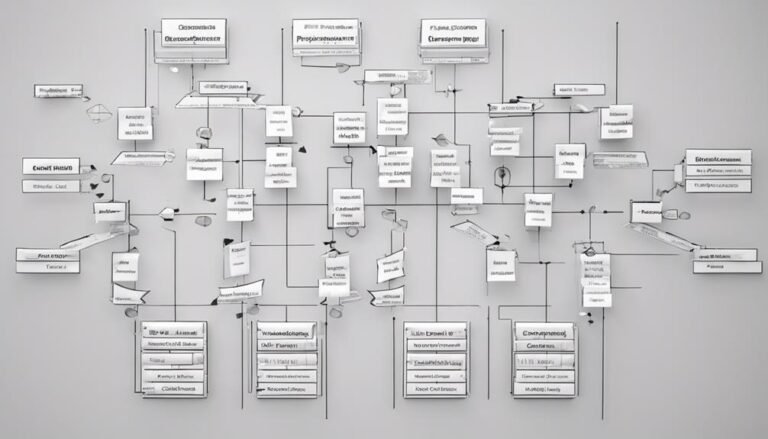Current Ratio Explained With Formula and Examples
The current ratio is a critical financial measure that assesses a company's liquidity and ability to cover short-term liabilities. Calculated by dividing current assets by current liabilities, it indicates the firm's short-term financial health. A ratio below 1.0 may indicate financial risk, while above 1.0 suggests the capacity to meet short-term debts. By analyzing Apple Inc.'s current ratio, one can gain insights into its financial stability and management of assets and liabilities. Understanding this ratio is crucial for investors and stakeholders to evaluate a company's short-term obligations. Further exploration will uncover the nuances of comparing ratios and determining optimal levels.
Key Takeaways
- Current ratio compares current assets to liabilities for short-term financial analysis.
- Formula: Current assets / Current liabilities.
- Ratio below 1.0 may indicate financial risk; above 1.0 shows ability to meet debts.
- Apple Inc.'s current ratio fluctuations reflect liquidity management strategies.
- Industry benchmarks guide optimal current ratio targets for different sectors.
Definition and Significance
The current ratio, an essential financial metric in corporate analysis, compares a company's current assets to its current liabilities to evaluate its ability to meet short-term financial obligations. Analysis methods for this ratio involve evaluating the efficiency of asset utilization and the company's liquidity position.
When conducting industry comparisons, it is important to take into account the varying norms and practices across different sectors. This metric provides insights into how well a company can cover its short-term debts. However, challenges may arise when comparing ratios between industries due to differing operational structures and financial practices.
Understanding these nuances is vital for a thorough evaluation of a company's financial health and performance against industry benchmarks.
Formula and Interpretation
Analyzing the current ratio involves evaluating the relationship between a company's current assets and current liabilities to gauge its short-term financial position. The formula for calculating the current ratio is straightforward: Current Ratio = Current assets / Current liabilities.
This formula analysis provides insights into a company's liquidity and ability to cover short-term obligations. Interpretation of the current ratio is important, as a ratio below 1.0 may signal financial risk, while a ratio above 1.0 suggests the capacity to meet short-term debts.
When conducting industry comparisons, it's crucial to take into account variations in asset quality and liquidity that can influence the effective current ratio. Understanding these nuances is essential for accurate financial analysis and decision-making.
Apple Inc. Example Analysis
How does Apple Inc.'s current ratio performance reflect its short-term financial stability and liquidity position?
Apple Inc.'s current ratio, which fluctuated from 1.075 to 0.88 in 2021 and 2022, plays an important role in evaluating its liquidity and financial health. A current ratio below 1.0, as seen in Apple's case at times, may signal potential financial risk and an inability to cover short-term obligations adequately. On the other hand, a ratio above 1.0 suggests that the company can meet its short-term debts.
Analyzing Apple Inc.'s current ratio provides insights into how efficiently the company manages its current assets and liabilities, offering valuable information for investors and stakeholders interested in the tech giant's financial stability.
Key Takeaways and Challenges
Apple Inc.'s fluctuating current ratio, which reflects its short-term financial stability, leads to a deeper examination of key takeaways and challenges in evaluating its liquidity position. Trending analysis of Apple's current ratio over time can reveal patterns that indicate the company's liquidity management.
However, challenges arise when comparing this ratio with industry benchmarks due to varying business models and sector-specific liquidity requirements. Understanding the impact of asset quality and the aging of accounts receivable is important in interpreting the current ratio accurately. It is essential to take into account contextual factors that may influence the ratio's calculation.
Despite these challenges, the current ratio remains a valuable tool for evaluating a company's ability to meet short-term obligations, especially when used in conjunction with other liquidity ratios.
Comparison and Optimal Ratio
When evaluating a company's financial health, contrasting the current ratio with other liquidity ratios can offer a thorough analysis of its liquidity position.
While the current ratio provides a broad view of liquidity, comparing it with metrics like the acid-test ratio, cash ratio, days sales outstanding, and operating cash flow ratio can offer a more in-depth assessment.
Industry benchmarks play a vital role in determining the most suitable current ratio for a company. Generally, a current ratio of 1.50 or higher indicates ample liquidity; however, the adequacy of this ratio is best understood in the context of industry norms and historical performance.
It is essential to take into account variations in asset quality, liquidity, and the need for detailed analysis using multiple liquidity ratios to gauge a company's financial health accurately.
Conclusion
To sum up, the current ratio acts as a compass guiding stakeholders through the financial landscape, offering insights into a company's short-term liquidity and ability to meet obligations.
By understanding its formula, interpretation, and practical examples like Apple Inc., one can navigate the challenges, comparisons, and ideal ratios associated with this fundamental metric.
The current ratio remains a valuable tool in evaluating a company's financial stability and making informed decisions.







